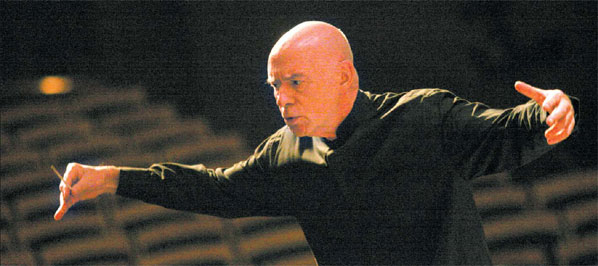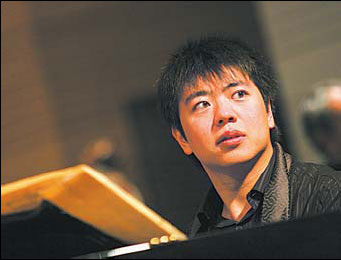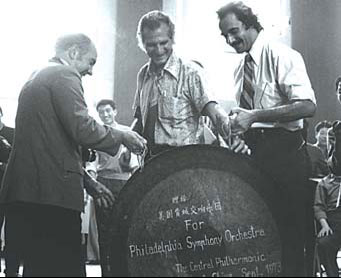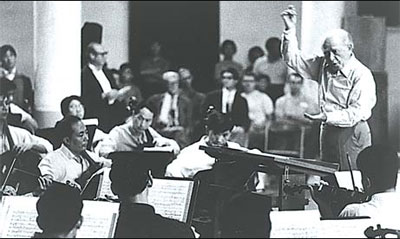Notes of harmony
|
Philadelphia Orchestra music director Christoph Eschenbach will take the baton for the commemorative concerts. Jiang Dong |
The New York Philharmonic's bridge-building visit to Pyongyang in February struck many a chord among audiences, reminding them of "symphonic diplomacy".
Less than three months later, on May 7, the China Philharmonic Orchestra performed for the Pope at the Paul VI Audience Hall in the Vatican.
This time, both Western and Chinese press compared the visit to the Philadelphia Orchestra's unprecedented trip to China 35 years ago.
Back in September 1973, the Philadelphia Orchestra had become the first American orchestra to play in China.
That trip has long been considered the most famous example of symphonic diplomacy for China.
To commemorate the 35th anniversary of the historic visit, the Philadelphia Orchestra returns to China with two concerts in Beijing (June 2 and 3), one in Guangzhou (June 6) and two in Shanghai (June 7 and 8). The concerts are part of a three-week Asian tour following the close of its 2007-08 subscription season.
|
Pianist Lang Lang will join the China tour of the Philadelphia Orchestra. Jiang Dong |
Philadelphia Orchestra music director Christoph Eschenbach takes the baton and world-renowned Chinese pianist Lang Lang joins the tour for four concerts.
On June 2, the China International Friendship Association will organize a gala concert and dinner in Beijing to celebrate the anniversary. The concert will run at the Cultural Palace of Nationalities, where the Orchestra performed in 1973.
The Philadelphia Orchestra will also perform two works that were on the program in 1973: The Yellow River Concerto, featuring Lang Lang, and Beethoven's Symphony No 6 ("Pastoral").
"I am so pleased to once again share the magnificent artistry of the fine musicians of the Philadelphia Orchestra with our audiences in Asia this spring," says Eschenbach.
"The Philadelphia Orchestra has a great tradition of sharing its music with audiences around the world, and it gives us great pleasure to continue this with our 2008 Anniversary Tour of Asia, which commemorates important anniversaries in both China and Korea," says Philadelphia Orchestra Association president and CEO James Undercofler.
"Through these many visits, we have developed rich friendships with many wonderful people, who share our belief that the transformational power of music bridges cultural differences and brings people together."
In 1971, Philadelphia Orchestra music director Eugene Ormandy wrote a letter to US President Nixon proposing a tour to China.
The next year, Nixon and then US national security advisor Henry Kissinger visited China, paving the way for the concert in Beijing and Shanghai.
Philadelphia was thought of as the natural choice for Nixon, who had been honored at the orchestra's anniversary concert a year before. Ormandy was considered suitable, too, because he had conducted a China Relief concert in Australia 30 years before.
"The quiet negotiations that preceded the tour must have been extraordinary. Talks were intricate. There was no such thing as having orchestra manager Boris Sokoloff sit down with a Chinese impresario, give him dates and a list of players, repertoire, and housing and travel needs. Communication was through shadowy diplomatic ties," wrote journalist Daniel Webster in his article Revisiting the Philadelphia Orchestra's Historic 1973 Tour to China. Webster, a former music critic of the Philadelphia Inquirer, was one of the press members in that trip.
Ormandy proposed many programs, but after the approval of Chairman Mao Zedong's wife, Jiang Qing, the orchestra was finally allowed to play Debussy, Beethoven, Schubert, Brahms, Roy Harris' Symphony No 3, and the Chinese piano concerto Yellow River. Chinese pianist Yin Chengzong played the concerto with the orchestra.
|
The Central Philharmonic Society of China gives the Philadelphia Orchestra a new brass gong in 1973. Photos courtesy of The Philadelphia Orchestra Association Archives |
At that time, there was no direct flight from the US to China. The orchestra spent a night in Honolulu and flew to Tokyo, before finally arriving in Beijing.
Webster wrote that trumpeter Don McComas and trombonist Glenn Dodson had joined others to play Frisbee with the crowds in the streets. On the second morning they arrived in Beijing, concertmaster Norman Carol and a number of other violinists joined the snaking line of Chinese buying flat pancakes fried on charcoal grills in the streets.
"The Philadelphia Orchestra's performance was so moving that I saw tears in many eyes of the audience. The Western music was forbidden during the 'cultural revolution' (1966-76), but when we heard their performance, many Chinese musicians were encouraged to take up instruments again," recalls pianist Liu Shikun, who was part of the audience for the concerts, and had played Liszt for the orchestra one night.
In addition to their four concerts at the Cultural Palace of Nationalities, the players visited the Great Wall, the Ming Tombs, the Summer Palace and the Forbidden City. They also watched ballet The White Haired Girl.
Ormandy and some players visited the Central Philharmonic Society of China (now National Symphony Orchestra) and met its conductor Li Delun (1917-2001).
Under the baton of Li, the Chinese orchestra played one movement of Beethoven's Symphony No 5 for the American visitors. Li then asked Ormandy to conduct.
"Ormandy took the baton, smiled at the nervous players, raised the baton and made an orchestra. The tattered group remembered who they were: They dug their bows into the strings, the bassoons found intonation, and these 'cultural workers' were musicians again," wrote Webster in his article.
"Most of the members had been workers or cultivated fields since the 'cultural revolution' began in 1966. Our instruments were chipped and glued together, and the score we played was hand copied. We did not play Beethoven well but Ormandy was so nice," recalls bassoon player Liu Qi.
Ormandy later asked the Central Philharmonic Society to play a Chinese piece. Li conducted for The Moon Reflected on the Second Spring. Ormandy was so impressed by the music that he asked to bring back a score of it.
The musicians from both countries exchanged instruments as gifts and it was the initiation of a long-lasting relationship.
Violist Leonard Mogill sent scores to colleagues for years after the tour. Percussionist Alan Abel tried out folk instruments and gave the Chinese seminars on what the Americans played. Bassist Carl Torello, his body abraded by decades of play, returned home as an advocate for acupuncture.
Ten musicians of the orchestra who were on the 1973 trip will return to China next month. They all remember their first visit clearly and look forward to the commemoration tour.
"It was a good idea to repeat the 1973 program I hope that we and the Chinese realize how important our mutual friendships are," says bassist Neil Courtney, who joined the orchestra in 1962.
Courtney remembers trying to prepare for the 1973 visit as soon as he heard about it, by reading.
"One book was Prisoners of the Liberation by an American couple I knew, and the other was about spending a year in a Chinese village," recalls the bassist, who bought several recordings of traditional instruments and had left a bass bow case for a bass player then.
"I had the impression of a people who had taken responsibility for their country. I think the tour served as a major diplomatic triumph," he says.
|
Philadelphia Orchestra music director Eugene Ormandy rehearses the Central Philharmonic Society of China in September 1973. |
Violinist Herbert Light, who joined the orchestra in 1960, says the 1973 trip seemed like "a great adventure". He remembers watching the ballet The White-haired Girl and the banquets with multiple "ganbei".
Harpist Margarita Montanaro was three months pregnant when she arrived in China in 1973.
"It was one of the most interesting trips ... I believe it helped a lot in cementing good relations with the Chinese. I was very excited about going ... I did not know what to expect," she says.
"I was surprised to find such a different world in China. There were almost no cars, tons of bicycles and everybody wore the same gray or navy Mao jackets. The people were very friendly, but reserved in their speech.
"The transformation of China from the 70s to China today is one of the most amazing things the world has ever seen, very hard to believe unless you had seen it yourself back then."
(China Daily 05/27/2008 page19)


















